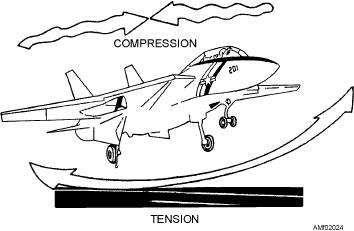
wood were developed and used on later aircraft.
When an aircraft is on the ground, there is a
Materials currently used in aircraft construction may be
bending force on the fuselage. This force occurs
classified as either metallic or nonmetallic.
because of the weight of the aircraft itself. Bending
greatly increases when the aircraft makes a carrier
METALLIC MATERIALS
landing. This bending action creates a tension stress on
the lower skin of the fuselage and a compression stress
The most common metals in aircraft construction
on the top skin. This bending action is shown in figure
are aluminum, magnesium, titanium, steel, and their
2-24. These stresses are also transmitted to the fuselage
alloys. Aluminum alloy is widely used in modern
when the aircraft is in flight. Bending occurs due to the
aircraft construction. It is vital to the aviation industry
reaction of the airflow against the wings and
because the alloy has a high strength-to-weight ratio.
empennage. When the aircraft is in flight, lift forces act
Aluminum alloys are corrosion-resistant and
upward against the wings, tending to bend them
comparatively easy to fabricate. The outstanding
upward. The wings are prevented from folding over the
characteristic of aluminum is its lightweight.
fuselage by the resisting strength of the wing structure.
This bending action creates a tension stress on the
Magnesium, the world's lightest structural metal, is
bottom of the wings and a compression stress on the top
a silvery-white material weighing only two-thirds as
of the wings.
much as aluminum. Magnesium is used in the manu-
facture of helicopters. Magnesium's low resistance to
Q2-20.
What type of stress is produced by two forces
corrosion has limited its use in conventional aircraft.
pulling in opposite directions along the same
straight line?
Titanium
is
a
lightweight,
strong,
corrosion-resistant metal. It was discovered years ago,
Q2-21.
What force is the opposite of tension?
but only recently has it been made suitable for use in
Q2-22.
What type of stress is a combination of ten-
aircraft. Recent developments make titanium ideal for
sion and compression?
applications where aluminum alloys are too weak and
stainless steel is too heavy. In addition, titanium is
Q2-23.
What type of stress is the result of a twisting
unaffected by long exposure to seawater and marine
force?
atmosphere.
An alloy is composed of two or more metals. The
MATERIALS OF CONSTRUCTION
metal present in the alloy in the largest portion is called
LEARNING OBJECTIVES: Identify the
the base metal. All other metals added to the alloy are
various types of metallic and nonmetallic
called alloying elements. Alloying elements, in either
materials used in aircraft construction.
small or large amounts, may result in a marked change
An aircraft requires materials that must be both
in the properties of the base metal. For example, pure
light and strong. Early aircraft were made of wood.
aluminum is relatively soft and weak. When small
Lightweight metal alloys with a strength greater than
amounts of other elements such as copper, manganese,
and magnesium are added, aluminum's strength is
increased many times. An increase or a decrease in an
alloy's strength and hardness may be achieved through
heat treatment of the alloy. Alloys are of great im-
portance to the aircraft industry. Alloys provide materi-
als with properties not possessed by a pure metal alone.
Alloy steels that are of much greater strength than
those found in other fields of engineering have been
developed. These steels contain small percentages
of carbon, nickel, chromium, vanadium, and
molybdenum. High-tensile steels will stand stresses of
50 to 150 tons per square inch without failing. Such
steels are made into tubes, rods, and wires. Another
type of steel that is used extensively is stainless steel.
This alloy resists corrosion and is particularly valuable
Figure 2-24.--Bending action occurring during carrier
for use in or near salt water.
landing.
2-20

